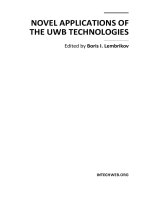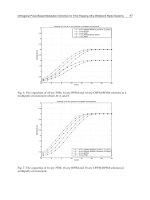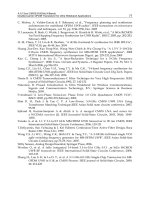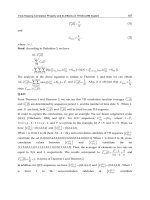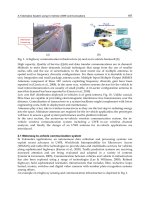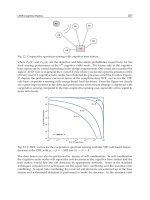Novel Applications of the UWB Technologies Part 1 pdf
Bạn đang xem bản rút gọn của tài liệu. Xem và tải ngay bản đầy đủ của tài liệu tại đây (1.19 MB, 30 trang )
NOVEL APPLICATIONS OF
THE UWB TECHNOLOGIES
Edited by Boris I. Lembrikov
Novel Applications of the UWB Technologies
Edited by Boris I. Lembrikov
Published by InTech
Janeza Trdine 9, 51000 Rijeka, Croatia
Copyright © 2011 InTech
All chapters are Open Access articles distributed under the Creative Commons
Non Commercial Share Alike Attribution 3.0 license, which permits to copy,
distribute, transmit, and adapt the work in any medium, so long as the original
work is properly cited. After this work has been published by InTech, authors
have the right to republish it, in whole or part, in any publication of which they
are the author, and to make other personal use of the work. Any republication,
referencing or personal use of the work must explicitly identify the original source.
Statements and opinions expressed in the chapters are these of the individual contributors
and not necessarily those of the editors or publisher. No responsibility is accepted
for the accuracy of information contained in the published articles. The publisher
assumes no responsibility for any damage or injury to persons or property arising out
of the use of any materials, instructions, methods or ideas contained in the book.
Publishing Process Manager Viktorija Zgela
Technical Editor Teodora Smiljanic
Cover Designer Jan Hyrat
Image Copyright Sura Nualpradid, 2010. Used under license from Shutterstock.com
First published July, 2011
Printed in Croatia
A free online edition of this book is available at www.intechopen.com
Additional hard copies can be obtained from
Novel Applications of the UWB Technologies, Edited by Boris I. Lembrikov
p. cm.
978-953-307-324-8
free online editions of InTech
Books and Journals can be found at
www.intechopen.com
Contents
Preface IX
Part 1 General Aspects of UWB Communication Systems 1
Chapter 1 Multiband OFDM Modulation and
Demodulation for Ultra Wideband Communications 3
Runfeng Yang and R. Simon Sherratt
Chapter 2 Orthogonal Pulse-Based Modulation Schemes
for Time Hopping Ultra Wideband Radio Systems 31
Sudhan Majhi and Youssef Nasser
Chapter 3 A 0.13um CMOS 6-9GHz 9-Bands Double-Carrier
OFDM Transceiver for Ultra Wideband Applications 59
Li Wei, Chen Yunfeng, Gao Ting, Zhou Feng,
Chen Danfeng, Fu Haipeng and Cai Deyun
Chapter 4 Implementation-Aware System-Level Simulations for
IR-UWB Receivers: Approach and Design Methodology 79
Marco Crepaldi, Ilze Aulika and Danilo Demarchi
Chapter 5 Time-Hopping Correlation Property
and Its Effects on THSS-UWB System 97
Zhenyu Zhang, Fanxin Zeng, Lijia Ge and Guixin Xuan
Chapter 6 Fine Synchronization in UWB Ad-Hoc Environments 123
Moez Hizem and Ridha Bouallegue
Part 2 Novel UWB Applications in Networks 141
Chapter 7 High-Speed Wireless Personal Area
Networks: An Application of UWB Technologies 143
H. K. Lau
Chapter 8 UWB Technology for WSN Applications 159
Anwarul Azim, M. A Matin, Asaduzzaman and Nowshad Amin
VI Contents
Chapter 9 Green Femtocell Based on UWB Technologies 175
Moshe Ran and Yossef Ben Ezra
Chapter 10 A Telematics System Using
In-Vehicle UWB Communications 195
I.J. Garcia Zuazola, J.M.H. Elmirghani and J.C. Batchelor
Part 3 Novel UWB Applications
in Cognitive Radio Systems 209
Chapter 11 UWB Cognitive Radios 211
Sithamparanathan Kandeepan, Gianmarco Baldini
and Radoslaw Piesiewicz
Chapter 12 Detection and Avoidance Scheme
for DS-UWB System:
A Step Towards Cognitive Radio 237
Shaoyi Xu and Rumin Yang
Chapter 13 Performance Analysis of Spectrum
Management Technique by Using Cognitive Radio 263
Keisuke Sodeyama and Ryuji Kohno
Part 4 Novel UWB Applications in Medicine 273
Chapter 14 The Future of Ultra Wideband
Systems in Medicine:
Orthopedic Surgical Navigation 275
Mohamed Mahfouz, Michael Kuhn and Gary To
Chapter 15 Ultra-Wideband Pulse-Based Microwave
Imaging for Breast Cancer Detection:
Experimental Issues and Compensations 317
Joshua C. Y. Lai, Cheong Boon Soh,
Kay Soon Low and Erry Gunawan
Chapter 16 Frequency Domain Skin Artifact Removal
Method for Ultra-Wideband Breast Cancer Detection 337
Arash Maskooki, Cheong Boon Soh,
Erry Gunawan and Kay Soon Low
Part 5 Novel UWB Application in Radars
and Localization Systems 357
Chapter 17 Full-Wave Modelling of Ground-Penetrating
Radars: Antenna Mutual Coupling Phenomena
and Sub-Surface Scattering Processes 359
Diego Caratelli and Alexander Yarovoy
Contents VII
Chapter 18 Impact of Ultra Wide Band Emission on Next Generation
Weather RADAR and the Downlink of UMTS2600 381
Bazil Taha Ahmed and Miguel Calvo Ramon
Chapter 19 High-Precision Time-of-Arrival Estimation for UWB Localizers
in Indoor Multipath Channels 397
Marzieh Dashti, Mir Ghoraishi,
Katsuyuki Haneda and Jun-ichi Takada
Chapter 20 Novel Mechanisms for Location-Tracking Systems 423
Giuseppe Destino and Giuseppe Abreu
Preface
Ultra wideband (UWB) communication systems are characterized by high data rates,
low cost, multipath immunity, and low power transmission. They are widely used in
wireless communications, networking, radar, imaging, and positioning systems. In
2002, the Federal Communication Commission (FCC) legalized low power UWB
emission between 3.1 GHz and 10.6 GHz for indoor communication devices
stimulating many novel UWB applications such as personal area networks (PANs),
accurate tracking and location, safety and homeland security.
Since then, UWB technologies attracted a great research and practical interest. In
recent years, UWB technologies have been rapidly developing. The number of
scientific articles concerning different aspects of UWB technologies is enormous and
hardly observable. For this reason, it is important to present to the UWB community
an adequate review of novel UWB technology applications. We have tried our best in
order to provide such a review in the proposed book Novel Applications of the UWB
Technologies. The book is divided into five parts concerning the UWB communication
systems, and UWB applications in PANs, medicine, radars and localization systems.
Part 1, General Aspects of UWB Communication Systems, includes chapters 1 - 6
describing the general problems of UWB communication systems such as modulation
formats, transmitter and receiver architecture, UWB communication system
performance.
Part 2, Novel UWB Applications in Networks, includes chapters 7 - 10 related to
novel UWB applications in wireless personal area networks (WPANs), wireless sensor
networks (WSNs), femtocells, and vehicles.
Part 3, Novel UWB Applications in Cognitive Radio Systems, consists of chapters
11 - 13 where the problems of UWB cognitive radio are considered.
Part 4, Novel UWB Applications in Medicine, includes chapters 14 - 16 where the
novel UWB technology applications in medicine are presented.
Finally, part 5, Novel UWB Application in Radars and Localization Systems, consists
of chapters 17 - 20 and describes the UWB radar and localization problems.
X Preface
Consider briefly the outline of the chapters.
In Chapter 1, the multiband orthogonal frequency division multiplexing (MB-OFDM)
modulation and demodulation are considered. In order to optimize the UWB system
performance the authors proposed a cost-effective and high performance modulation
scheme based on quadrature phase shift keying (QPSK) and dual carrier modulation
(DCM).
In Chapter 2, the time hopping (TH)-UWB system model based on orthogonal pulse
waveform is presented. The chapter contains a detailed analysis of the pulse based
modulation schemes over multipath channel and power spectral density (PSD) for
pulse shape modulation (PSM), bi-orthogonal PSM (BPSM), and combined modulation
scheme of orthogonal pulse position modulation (OPPM)-BPSM.
In Chapter 3, a fully integrated CMOS 6-9 GHz 9 bands transceiver for double carrier
(DC) OFDM UWB system realized on the chip is described in detail. It is shown in
particular that 9 carrier frequencies from 6336 MHz up to 8712 MHz with a frequency
gap of 264 MHz are available.
In Chapter 4, a novel simulation methodology of impulse radio (IR) UWB energy
detection receiver has been developed.
In Chapter 5, the correlation properties of the time-hopping (TH) sequences for TH
spread spectrum (THSS) UWB systems are analyzed. The theory of TH sequences is
developed and a method to improve TH sequences correlation properties is proposed.
In Chapter 6, the problem of UWB system performance in single-user and multi-user
environments is discussed. A fine synchronization algorithm for pulse amplitude
modulation (PAM) and pulse position modulation (PPM) UWB signals with a spread
spectrum involving TH is proposed.
In Chapter 7, a comprehensive review of the latest developments in the field of high-
speed WPANs is provided. UWB technology is especially promising for WPAN
applications due to high bandwidth and small communication ranges.
In Chapter 8, the UWB technology applications in WSNs are analyzed. UWB
technology manifests high robustness to interference and provides low complexity
and low energy consumption receivers and transmitters for WSNs.
In Chapter 9, a novel concept of the fourth generation femtocell is proposed. The
system is based on a recently developed UWB-radio-over-optical-fiber (UROOF)
technology. It is characterized as a green femtocell since its energy consumption is
significantly lower as compared to wireless systems.
In Chapter 10, a novel interesting application of UWB technology is described that
combines the advantages of the low cost radio-over-fiber (RoF) links and wireless
Preface XI
propagation of UWB radio signals inside a vehicle. UWB is able to provide high data
rates while RoF technology extends the UWB radio transmission over comparatively
long distances in trains, trams and airplanes.
In Chapter 11, the UWB communication is presented as a promising candidate for
cognitive radio (CR) technology. CRs are the intelligent radios adopting itself by
sensing and learning the radio environment in order to optimize the transmission
strategies. Several possible scenarios and applications for the UWB based CR are
discussed.
In Chapter 12, the detection-and-avoidance (DAA) cognitive UWB scheme is
proposed. It is shown that DAA as a CR scheme is effective for MB UWB group.
In Chapter 13, the design and performance of the UWB cognitive radio system with
DAA technique are investigated.
In Chapter 14, the UWB applications in medicine are reviewed in detail. The UWB
systems for the 3D localization, the research systems, the aspects of the microwave
radiation interaction with biological tissues, and state-of-the-art in wireless medical
systems are discussed. Novel experimental results for electromagnetic interference in
the operating room are presented.
In Chapter 15, the experimental aspects of the breast cancer detection based on the
UWB imaging are discussed.
In Chapter 16, a novel efficient method for the UWB cancer detection is proposed. A
corresponding mathematical model is developed and successfully applied for the
signal reconstruction.
In Chapter 17, the ground penetrating radar (GPR) operating at frequencies of about
0.5-1.6GHz is considered theoretically. The obtained numerical results describe
adequately the mechanisms of subsurface electromagnetic wave scattering and
antenna mutual coupling processes.
In Chapter 18, the effect of the UWB interference on the next generation weather radar
has been investigated. Different scenarios have been discussed concerning the UWB
antenna configurations and the environment influence on the UWB system
performance.
In Chapter 19, the UWB system applications in indoor ranging/localization are
reviewed. A novel algorithm for the time-of-arrival (ToA) estimation is developed, and
the simulation results are checked experimentally.
In Chapter 20, the current state-of-the-art localization techniques for large-scale and
single-loop networks are discussed. UWB technology attracted a significant interest
due to its accurate ranging capabilities and energy efficiency. Useful models for the
XII Preface
localization problem are presented, and numerical simulation results for UWB ranging
model are obtained.
We believe that this book will be helpful to engineers and researchers occupied in the
field of UWB technology.
July 2011
Dr. B. I. Lembrikov,
Faculty of Electronics, Electrical and Communication Engineering,
Holon Institute of Technology (HIT)
Israel
Part 1
General Aspects of UWB
Communication Systems
1
Multiband OFDM Modulation and Demodulation
for Ultra Wideband Communications
Runfeng Yang
1
and R. Simon Sherratt
2
1
Dongguan Polytechnic
2
University of Reading
1
China,
2
United Kingdom
1. Introduction
This chapter considers the Multiband Orthogonal Frequency Division Multiplexing (MB-
OFDM) modulation and demodulation with the intention to optimize the Ultra-Wideband
(UWB) system performance. OFDM is a type of multicarrier modulation and becomes the
most important aspect for the MB-OFDM system performance. It is also a low cost digital
signal component efficiently using Fast Fourier Transform (FFT) algorithm to implement the
multicarrier orthogonality. Within the MB-OFDM approach, the OFDM modulation is
employed in each 528 MHz wide band to transmit the data across the different bands while
also using the frequency hopping technique across different bands. Each parallel bit stream
can be mapped onto one of the OFDM subcarriers.
Quadrature Phase Shift Keying (QPSK) and Dual Carrier Modulation (DCM) are currently
used as the modulation schemes for MB-OFDM in the ECMA-368 defined UWB radio
platform. A dual QPSK soft-demapper is suitable for ECMA-368 that exploits the inherent
Time-Domain Spreading (TDS) and guard symbol subcarrier diversity to improve the receiver
performance, yet merges decoding operations together to minimize hardware and power
requirements. There are several methods to demap the DCM, which are soft bit demapping,
Maximum Likelihood (ML) soft bit demapping, and Log Likelihood Ratio (LLR) demapping.
The Channel State Information (CSI) aided scheme coupled with the band hopping
information is used as a further technique to improve the DCM demapping performance.
ECMA-368 offers up to 480 Mb/s instantaneous bit rate to the Medium Access Control
(MAC) layer, but depending on radio channel conditions dropped packets unfortunately
result in a lower throughput. An alternative high data rate modulation scheme termed Dual
Circular 32-QAM that fits within the configuration of the current standard increasing system
throughput thus maintaining the high rate throughput even with a moderate level of
dropped packets.
2. MB-OFDM in ECMA-368
2.1 UWB standardization
The fundamental issue of UWB is that the transmitted signal can be spread over an
extremely large bandwidth with very low Power Spectral Density (PSD). In early 2002, the
Novel Applications of the UWB Technologies
4
USA Federal Communications Commission (FCC) agreed to allocate 7500 MHz RF spectrum
in 3.1-10.6 GHz band for unlicensed use for the UWB devices (Federal Communications
Commission [FCC], 2002a), and limit the UWB Effective Isotropic Radiated Power (EIRP) to
-41.3 dBm/MHz (FCC, 2002b). In later 2002, Ellis et al (Ellis et al., 2002) published the initial
requirements specification for UWB systems.
Many UWB proposals were made to converge on an agreed solution. Two clear candidates
quickly emerged under the Institute of Electrical and Electronic Engineering (IEEE)
802.15.3a working party for Wireless Personal Area Network (WPAN), which were Direct-
Sequence (DS) UWB (Fisher et al., 2005) and MB-OFDM (Batra, et al., 2004a). In parallel with
the IEEE standardization attempted, the Multiband OFDM Alliance Special Interest Group
(MBOA-SIG) forged ahead to standardize their UWB system based on MB-OFDM. A key
activity in MBOA-SIG development was MB-OFDM being selected by the USB
implementers forum for the new Wireless-USB Physical layer (PHY) standard (USB
Implementers forum, 2005). In 2005, the WiMedia Alliance working with European
Computer Manufacturers Association (ECMA) announced the establishment of the
WiMedia MB-OFDM UWB radio platform as their global UWB PHY and Media Access
Control (MAC) standard, ECMA-368, based on the previous MBOA-SIG proposal
(Multiband OFDM Alliance, 2004) with only minor changes. A third updated version of
ECMA-368 was published in December 2008 with additions for regulatory flexibility and
maintained as ISO/IEC 26907 (ECMA, 2008).
ECMA-368 specifies an MB-OFDM system occupying 14 bands with a bandwidth of 528
MHz for each band. This technique has the capability to efficiently capture multipath energy
with a single RF chain. The first 12 bands are grouped into 4 band groups (BG1-BG4), and
the last two bands are grouped into a fifth band group (BG5). A sixth band group (BG6)
containing band 9, 10 and 11 is also defined within the spectrum of BG3 and BG4, in
agreement to usage within worldwide spectrum regulations. The advantage of the grouping
is that the transmitter and receiver can process a smaller bandwidth signal while taking
advantages from frequency hopping. Figure 1 depicts the band group allocation.
Band Group 5 Band Group 4 Band Group 3 Band Group 2 Band Group 1
f
Band
1
Band
2
Band
5
Band
4
Band
3
Band
8
Band
7
Band
6
Band
11
Band
10
Band
9
Band
14
Band
13
Band
12
4488
MH
Z
5016
MH
Z
5544
MH
Z
6072
MH
Z
6600
MH
Z
7128
MH
Z
7656
MH
Z
8184
MH
Z
8712
MH
Z
9240
MH
Z
9768
MH
Z
3960
MH
Z
3432
MH
Z
Centre
frequency
10296
MH
Z
Band Group 6
Fig. 1. Band group allocation (ECMA-International, 2008)
2.2 PHY operation in MB-OFDM
To operate the PHY service interface to the MAC, a Physical Layer Convergence Protocol
(PLCP) sublayer is defined to provide a method for converting a PSDU (PHY Service Data
Unit) into a PPDU (PLCP Packet Data Unit) composed from three components: the PLCP
preamble (containing the Packet/Frame Synchronization and the Channel Estimation
Multiband OFDM Modulation and Demodulation for Ultra Wideband Communications
5
sequence), the PLCP header, and the PSDU, as illustrated in Figure 2. They are added with
appropriated error detection and correction schemes to robust a communication channel as
practically possible. When transmitting the packets, the PLCP preamble is sent first,
followed by the PLCP header, and finally the PSDU. At the receiver, the PLCP preamble and
PLCP header are processed to aid in the demodulation, decoding and delivery of the PSDU.
Fig. 2. PPDU structure
To transmit a PSDU that contains the information bits, ECMA-368 has eight transmission
modes by applying various levels of coding and diversity to offer 53.3, 80, 106.7, 160, 200,
320, 400 or 480 Mb/s. Firstly the PSDU needs to be scrambled by the scrambler, then it is
encoded by puncturing the convolutional code to achieve the appropriate coding rate, 1/3,
1/2, 5/8 or 3/4, interleaved and modulated onto a QPSK complex constellation for data
rates 200 Mb/s and lower, or DCM for data rates 320 Mb/s and higher. After bit
interleaving, the coded and interleaved binary data sequence is mapped onto a QPSK or
DCM complex constellation. The resulting complex numbers are loaded onto the data
subcarriers of the OFDM symbol implemented using an IFFT to create real or complex
baseband signal. Figure 3 depicts the encoding process for the PSDU at the transmitter.
QPSK or
DCM
Mapper
Bit
Interleaver
PSDU
Convolutional
Encoder /
Puncturer
IFFT
)(kT
Y
Scramble
r
Fig. 3. Encoding process for the PSDU at Transmitter
At the heart of ECMA-368 lies a 128-pt IFFT with a 242.42ns IFFT period resulting in each
IFFT subcarrier being clocked at 528MHz. The subcarriers in each OFDM symbol include
100 data subcarriers, 12 pilot subcarriers, 6 NULL valued subcarriers and 10 guard
subcarriers. The 10 guard subcarriers used for mitigating Inter Symbol Interference (ISI) are
located on either edge of the OFDM symbol and have same value as the 5 outermost data
subcarriers. Each OFDM symbol is separated with a Zero Padded Suffix (ZPS) of 70.08ns (37
zeros as the FFT rate) to aid multipath interference mitigation and settling times of the
transmitter and receiver. The IFFT/FFT operation ensures that subcarriers do not interfere
with one other. Moreover, Frequency-Domain Spreading (FDS) and Time-Domain
Spreading (TDS) can be used to obtain further bandwidth expansion within the OFDM
modulation process depending on the coding scheme in ECMA-368.
2.3 Frequency hopping
ECMA-368 employs a frequency hopping technique in which the band is hopped by using a
Time-Frequency code (TFC) known to both transmitter and receiver. The transceiver
transmits a single OFDM symbol in one band, and then the next transmitted OFDM symbol
is hopped to the next band. Figure 4 depicts OFDM symbols transmitted in RF signal
12 or 24 OFDM
Symbols
PLCP preamble
12 OFDM
Symbols
53.3, 80,106.7, 160,
200, 320, 400, 480 Mb/s
6 OFDM
Symbols
PLCP Header Channel Estimate PSDU Packet/Frame Sync
Novel Applications of the UWB Technologies
6
utilizing a TFC within Band group 1 (BG1). There are two types of TFCs: Time-Frequency
Interleaving (TFI), where the coded information is interleaved over three bands; and Fixed-
Frequency Interleaving (FFI), where the coded information is transmitted on a single band.
BG1 is a mandatory mode targeted for the first generation UWB devices.
IFFT Output
(OFDM Symbol, T
FFT
=242.42ns)
Time
Symbol (T
sym
=312.5ns)
3168
3696
4224
4752
Band 1
Band 2
Band 3
Frequency(MH
Z
)
ZPS (T
zps
=70.8ns)
Fig. 4. OFDM symbols transmitted in RF signal utilizing a TFC within BG1
2.4 System performance measurements
Simulating system performance is an important criterion in order to compare to current
literature. However, the literature on MB-OFDM system performance for measuring
propagation with respect to distance is surprisingly sparse. We followed the original
MBOA-SIG MB-OFDM proposal settings and adopted the assumptions (described in the
following section 2.4.2) to simulate the MB-OFDM system with standard UWB channels.
2.4.1 Propagation distance measurement
The received signal power is calculated the difference between the total transmit power and
path loss. Since the FCC defines the average power as 1mW per Megahertz, the total
transmitted power P
TX
can be obtained from the PSD and the operating bandwidth, as in (1)
assuming no power loss at the transmitter and 0 dBi transmit antenna gain.
10
41.25 10lo
g
()
TX U L
Pff
dBm (1)
where -41.25 dBm/MHz is the UWB EIRP/MHz, f
L
= 3168 MHz is the lower frequency of
the operating bandwidth, f
U
is upper frequency varying from BG1 to BG6. However, BG1 is
used for first generation of UWB devices, thus f
U
= 4752 MHz is assigned. The free-space
propagation model is defined under IEEE 802.15.3a, which specifies the path loss
attenuating the transmitted signal as a function of the lower and upper frequencies of the
operating bandwidth. The path loss P
L
can be expressed as in (2).
10
4
20lo
g
()
g
L
f
d
P
c
dB (2)
where f
g
= 3882 MHz is the geometric mean of the lower and upper frequencies in BG1. The
geometric mean offers a more reasonable value for the expected path loss in the system
(Batra et al., 2004b). d is the distance measured in meters between the transmitter and
Multiband OFDM Modulation and Demodulation for Ultra Wideband Communications
7
receiver. c = 3x108 m/s is the speed of light. As a result, the function of received signal
power, as described in (3), can be derived from (1) and (2) with transmit and receive antenna
gain (G
T
, G
R
).
RX TX T R L
PPGGP
dBm (3)
2.4.2 Receiver sensitivity
Receiver sensitivity is the lowest power level at which the receiver can detect an RF signal
and demodulate data. Sensitivity is purely a receiver specification and is independent of the
transmitter. In ECMA-368, the minimum receiver sensitivity values in Additive White
Gaussian Noise (AWGN) for different data rates are listed in Table 1 for BG1 to achieve a
Packet Error Rate (PER) of less than 8% with a payload of 1024 octets each in the PSDU,
where a noise figure of 6.6 dB (referenced at the antenna), an implementation loss of 2.5 dB,
and a margin of 3 dB have been assumed (ECMA, 2008).
Data Rate
(
Mb/s
)
Minimum Receiver Sensitivit
y
(
dBm
)
53.3 -80.8
80 -78.9
106.7 -77.8
160 -75.9
200 -74.5
320 -72.8
400 -71.5
480 -70.4
Table 1. Minimum receiver sensitivities for BG1 (ECMA, 2008)
2.4.3 System configuration
The proposed UWB system is simulated in a realistic multipath channel environment of 100
channel realizations in the four UWB channel models CM1-CM4 (Foerster, 2003). The
simulation results are averaged over at least 500 packets with a payload of 1024 octets each
in the PSDU and 90th-percentile channel realization (the worst 10% channels are discarded).
The link success probability is defined as the 90th-percentile of channel realizations for
which system can successfully acquire and demodulate a packet with a PER (a packet is in
error if at least one bit is in error) of less than 8% (Multiband OFDM Alliance, 2004).
The original MBOA-SIG proposal specifies implementation loss affecting the practical
system, which includes front-end filtering, clipping at the Digital-to-Analogue Converter
(DAC), Analogue-to-Digital Converter (ADC) degradation, channel estimation, clock
frequency mismatch (±20 ppm at the transmitter and receiver), carrier offset recovery,
carrier tracking, etc. Similarly, ECMA-368 specifies the total implementation loss of 2.5 dB
and a margin of 3 dB as an assumption. It should be noted that ECMA-368 only defines the
Novel Applications of the UWB Technologies
8
performance for reference sensitivity, not multipath. This research will revert back to
multipath test performed in the original MBOA-SIG tests when appropriate.
This research will maintain strict adherence to timing (no frequency offset and perfect
OFDM symbol timing) and use a hopping characteristic of TFC = 1, and incorporate 6.6 dB
noise figure referenced at the antenna and 2.5 dB implementation loss in the floating point
system model. PER being a function of distance will be used as a performance indicator for
the system performance measurement.
3. QPSK modulation
3.1 QPSK mapping
QPSK constellation mapping is used when data rate is 200 Mb/s or lower combing with
FDS and (or) TDS techniques. The FDS and TDS modes are not only used to create the
varied data rates, but also maximize frequency diversity and improve the performance.
ECMA-368 offers eight data rates with various levels of coding and diversity to achieve the
required trade-off between speed and reliability. For the slowest 5 out of the 8 PSDU coding
schemes (summarized in Table 2), or for the PLCP header, the binary coded and interleaved
input data are divided into groups of two bits, and then mapped in one of the four Gray-
coded QPSK constellation points, as in Figure 5. By mapping two bits per symbol, the
output symbol values Y[k], as in (4), are normalized by a normalization factor of K
MOD
=
1/
2
, to have constant average symbol power.
[ ] (2 [2 ] 1) (2 [2 1] 1)
MOD
Yk K b k j b k (4)
where k = 0, 1, 2, …n; n = 49 is used when FDS is enabled, otherwise n = 99.
Data
Rate
(Mb/s)
Modulation
Coding Rate
(R)
FDS TDS
Coded Bits /
6 OFDM symbol
Info Bits /
6 OFDM
symbol
53.3 QPSK 1/3 Yes Yes 300 100
80 QPSK 1/2 Yes Yes 300 150
106.7 QPSK 1/3 No Yes 600 200
160 QPSK 1/2 No Yes 600 300
200 QPSK 5/8 No Yes 600 375
320 DCM 1/2 No No 1200 600
400 DCM 5/8 No No 1200 750
480 DCM 3/4 No No 1200 900
Table 2. PSDU rate-dependent parameters (ECMA, 2008)
Multiband OFDM Modulation and Demodulation for Ultra Wideband Communications
9
-1
-1
1
1
)(kI
Y
)(kQ
Y
b[2k], b[2k+1]
11
01
10 00
Fig. 5. QPSK constellation mapping
ECMA-368 supports TDS and (or) FDS to provide repetition of the same information
(complex number) mapping over the OFDM symbols for the slowest 5 out of the 8 coding
schemes. In conjunction with the FDS approach, 50 QPSK symbols and 50 of their respective
conjugate values are mapped onto 100 OFDM data subcarriers as conjugate symmetric IFFT
inputs. As a result, the transmitter only needs to implement the real portion of the IFFT
output. As for the TDS approach, when 100 QPSK symbols are mapped onto an OFDM
symbol, the copy of these 100 QPSK symbols is mapped onto the next OFDM symbol.
3.2 A dual QPSK soft-demapper exploiting TDS and guard interval diversity
Soft bit decision is used to demap the QPSK to maximize the post-QPSK baseband
processing. However a soft bit based receiver will consume more memory in the
deinterleaver and increase the computational complexity of the Viterbi decoder, and it will
be required to store the soft bit trackback memory to search the 64 trellis states for each
information bit. The soft-QPSK demapping process can improve WPAN receiver
performance where each input complex number for the demapper outputs two soft bits
being the symbol likelihood. The demapping process can be simply the process of
outputting real part (I value) and then the imaginary part (Q value) of the input symbol for
the first and second soft bit respectively. For a given code bit, a positive soft bit with large
possible magnitude may indicate more confidence in ‘1’ being sent for the code bit, while a
negative soft bit with large possible magnitude may indicate more confidence in ‘0’ being
sent for the code bit, and a soft bit of zero may indicate equal likelihood of ‘0’ or ‘1’ being
sent for the code bit. The soft bits from the QPSK demodulator are then input to the bit
deinterleaver, then Viterbi decoder and descrambler to recover the original bit stream, as
shown in Figure 6.
QPS
K
Demodulator
Bit
Deinterleaver
Viterbi
Decoder
FFT
)(kR
Y
Channel
Equalizer
Scramble
d
Data
Fig. 6. Decoding process for the PSDU for low data rates or PLCP header at Receiver
Novel Applications of the UWB Technologies
10
3.2.1 Time-domain de-spreading and equal gain combing
As ECMA-368 implements frequency hopping, each time diversity pair in the TDS is
transmitted over a different frequency band and therefore has independent channel fading
characteristics. The possibility of both OFDM symbols having deep fades on the same
subcarriers from different frequency bands is small. The receiver may decide to select and
decode one received OFDM symbol or combine the two to maximize performance. Since the
duration of an OFDM symbol is fixed, the receiver may implement a single serial decoding
path for each symbol pair, or have two parallel decoding paths clocked at half the serial rate.
ne main OFDM symbol and its spread OFDM symbol are received at the receiver. After the
equalization, the data from those two OFDM symbols are demodulated by QPSK. Since
QPSK soft demapping is used for a pair of main and spread QPSK symbols, the receiver
must implement soft decision for the soft bit decoding. For two one-dimensional points (x
1
,
y
1
) and (x
2
, y
2
), the Euclidean distance is computed in (5). The spread decision can be
selected from calculating the Euclidean symbol distance between the corresponding QPSK
constellation point to a main QPSK symbol, Ym
k
, or a spread QPSK symbol, Ys
k
, and then
output the symbol that has shorter distance. d
m
and d
s
are the Euclidean distances for Ym
k
and Ys
k
respectively, as described in (6)-(7). Ym
k
and Ys
k
are the signals after the
equalisation. Figure 7 depicts possible QPSK symbol pairs from the main and spread OFDM
symbols.
22
21 21
()()dxx yy (5)
22
{Re( ) Re( )} {Im( ) Im( )}
mkn kn
dYmS YmS (6)
22
{Re( ) Re( )} {Im( ) Im( )}
skn kn
dYsS YsS (7)
where k = 0, 1…99; S
n
is the reference signal for one of the four constellation points. Then the
soft value of Ym
k
and Ys
k
is used after deciding the Euclidean distance, as the following:
221
()Re() ( )Im(),( )
kk k kms
Soft b Ym Soft b Ym if d d
(8)
221
()Re( ) ( )Im( ), ( )
kk k ksm
Soft b Ys Soft b Ys if d d
(9)
-1
-1
1
1
I(k)
dm
11
01
10
00
Ym
k
Q(k)
S
n
-1
-1
1
1
I(k)
Q(k)
d
s
11
01
10
00
Ys
k
S
n
Fig. 7. A possible equalized QPSK symbol pairs from the main and spread OFDM symbols
Multiband OFDM Modulation and Demodulation for Ultra Wideband Communications
11
Equal gain combing scheme can be employed to combine the spread sequence whether
before the QPSK demapping process or after the QPSK demapping process. The demapping
process can be integrated into the symbol decoding scheme and the combined QPSK soft-
demapping and TDS symbol simply reduces to (10) and (11). The overall likelihood of a
larger signal to noise ratio value is increased, thereby increasing more reliability for Viterbi
decoder input. This equal gain combing scheme not only has better soft decoding
performance than the spread decision, but also has much lower complexity.
2
()Re( )Re( )
kkk
Soft b Ym Ys
k = 0, 1, …99 (10)
21
( ) Im( ) Im( )
kkk
Soft b Ym Ys
(11)
3.2.2 Merged TDS and QPSK soft demapping architecture
Merging the TDS and QPSK soft-demapper architecture can be used to optimize the receiver
performance. At the rates where TDS is implemented, the receiver architecture can process
the main and spread OFDM symbols in parallel (to reduce hardware, but clock rates are
often high). In this proposed dual QPSK soft-demapper, the parallel approach is assumed,
as illustrated in Figure 8, but the serial approach can also be used where additional memory
for holding one equalizer output buffer is required before the two equalized symbols are
merged. The main and spread symbols have their own FFT and equalizer in the parallel
implementation. This may be considered as a consumptive resource solution, because too
much dynamic range is expensive in terms of power and floor size, particularly for the FFT.
To implement the demapping and combining process, the basic operations include fetching
I and Q values, add, shift, and store. The proposed dual QPSK demapper requires no
memory to hold the QPSK demapping output before the add operation. Thus a reduction of
40% required memory has been achieved compared to having separate demapping and
combining functions. The dual soft-QPSK demapping process and the management of
guard subcarriers are implemented with zero overhead.
Spread OFDM
Symbol
Main OFDM
Symbol
Ym
Ys
Soft bits
CE
FFT
Channel
Equalizer
Channel
Equalizer
FFT
Dual
QPSK
Demapper
CE=channel estimator sequence
Fig. 8. Architecture of soft-output QPSK demapper with TDS symbol combining
3.2.3 Use of guard subcarrier diversity
In ECMA-368, an OFDM symbol contains 100 data subcarriers (C
d
[0 99]), 10 guard
subcarriers (C
g
[0 9]), 12 pilot subcarriers (C
p
[0 11]) and 6 Null subcarriers. The 10 guard

